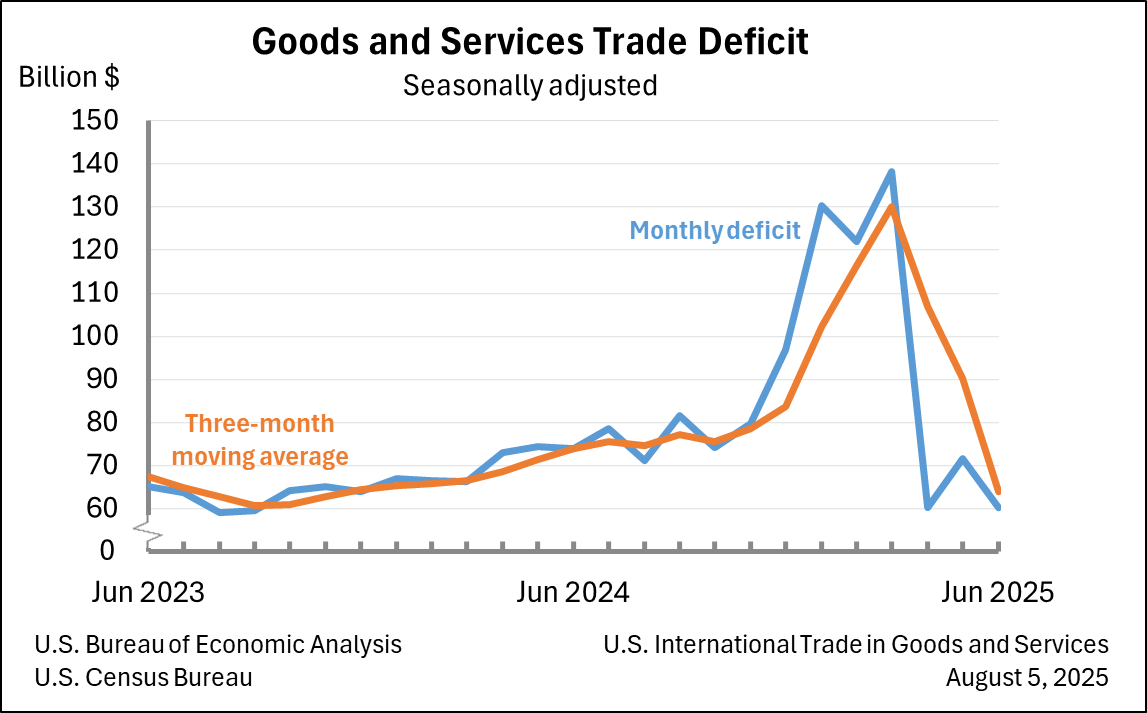Bureau of Economic Analysis
U.S. International Trade in Goods and Services, June 2025
The U.S. goods and services trade deficit decreased in June 2025 according to the U.S. Bureau of Economic Analysis and the U.S. Census Bureau. The deficit decreased from $71.7 billion in May (revised) to $60.2 billion in June, as exports decreased less than imports. The goods deficit decreased $11.4 billion in June to $85.9 billion. The services surplus increased $0.1 billion in June to $25.7 billion.
Principal Federal Economic Indicators
Noteworthy
- 2025 News Release Schedule
- Innovation at BEA
- 2025 Annual Updates
- Distribution of Personal Income Nowcast
- New! Services Trade Data for More Countries
- Data Tool: Trade in Value Added
- Updated: RIMS II Regional Multipliers
- Arts and Culture
- Space Economy
- FDI Now in State BEARFACTS
- Quick Guide: Price Indexes
The Latest
U.S. Current-Account Deficit Decreases in Third Quarter 2012
The U.S. current-account deficit—the combined balances on trade in goods and services, income, and net unilateral current transfers—decreased to $107.5 billion (preliminary) in the third quarter of 2012 from $118.1 billion (revised) in the second quarter of 2012. As a percentage of U.S. gross domestic product (GDP), the deficit decreased to 2.7 percent from 3.0 percent. The previously published current-account deficit for the second quarter…
U.S. International Transactions, 3rd quarter 2012
NOTE: See the navigation bar at the right side of the news release text for links to data tables, contact personnel and their telephone numbers, and supplementary materials. -->
Sarah Scott: (202) 606-9286 Paul W. Farello: (202) 606-9561 (Revisions)
Highlights of the Travel and Tourism Satellite Accounts for Third Quarter 2012
Real spending on travel and tourism slowed in the third quarter of 2012, increasing at an annual rate of 0.6 percent after increasing 2.2 percent in the second quarter. The primary contributor to the slowdown was a downturn in all other transportation-related commodities, which includes motor vehicle fuel, travel arrangement and reservations services, and automotive renting and leasing.
Travel and Tourism Satellite Accounts, 3rd quarter 2012
Real spending on travel and tourism slowed in the third quarter of 2012, increasing at an annual rate of 0.6 percent after increasing 2.2 percent (revised) in the second quarter. By comparison, growth in real gross domestic product (GDP) increased 2.7 percent (second estimate) in the third quarter of 2012 after increasing 1.3 percent in the second quarter.
BEA Provides Easier Access to Important Economic Measures
How fast is the economy growing? How much output is produced by labor and capital supplied by the United States? What income is generated by production? BEA produces several different measures for tracking production and economic growth in the United States. Gross domestic product (GDP) is one of the most widely used metrics, but there are several others that also provide important information on the condition of the United…
October 2012 Trade Gap is $42.2 Billion
The U.S. monthly international trade deficit increased in October 2012, according to the U.S. Bureau of Economic Analysis and the U.S. Census Bureau. The deficit increased from $40.3 billion (revised) in September to $42.2 billion in October, as exports decreased more than imports. The previously published September deficit was $41.5 billion. The goods deficit increased $1.8 billion from September to $59.2 billion in October, and the services…
Real Consumer Spending Falls in October
Personal income remained flat in October after increasing 0.4 percent in September. Wages and salaries decreased 0.2 percent in October after increasing 0.3 percent in September. The October decrease reflected work interruptions caused by Hurricane Sandy, which reduced wages and salaries by 0.3 percent. For more information, see the personal income news release.
Personal Income and Outlays, October 2012
Personal income increased $0.4 billion, or less than 0.1 percent, and disposable personal income (DPI) increased $0.8 billion, or less than 0.1 percent, in October, according to the Bureau of Economic Analysis. Personal consumption expenditures (PCE) decreased $20.2 billion, or 0.2 percent.
GDP Growth Accelerates in Third Quarter
Real gross domestic product (GDP) increased 2.7 percent in the third quarter of 2012 after increasing 1.3 percent in the second quarter, according to estimates released today by the Bureau of Economic Analysis. The third-quarter growth rate was revised up 0.7 percentage point from the advance estimate released in October.




